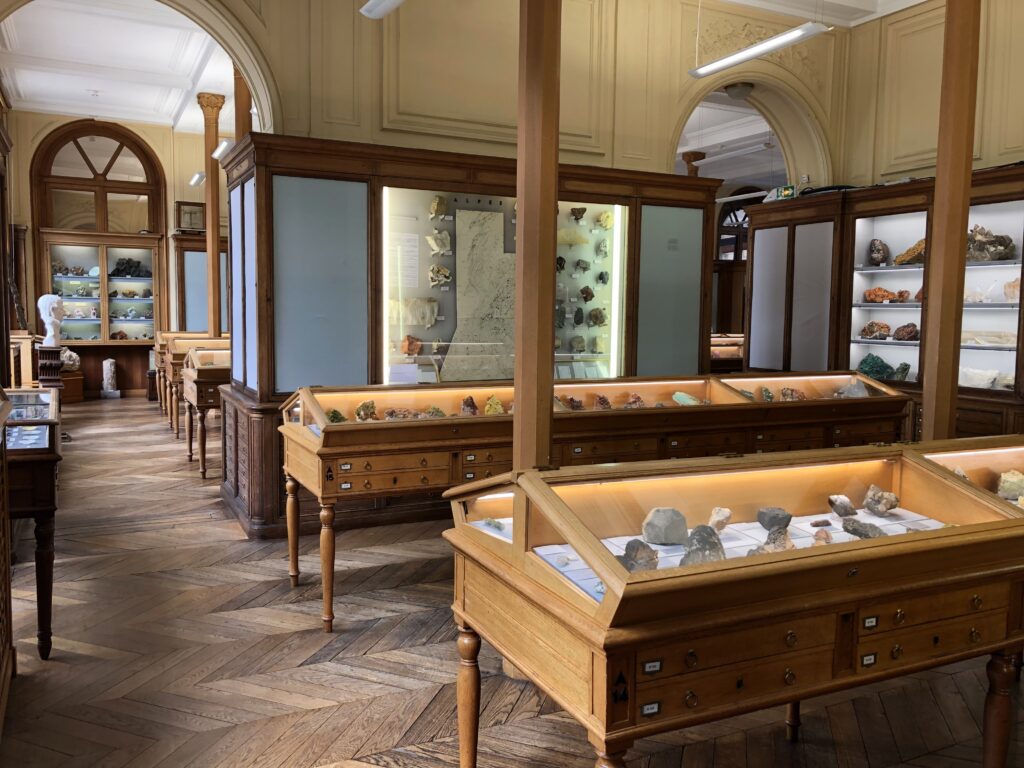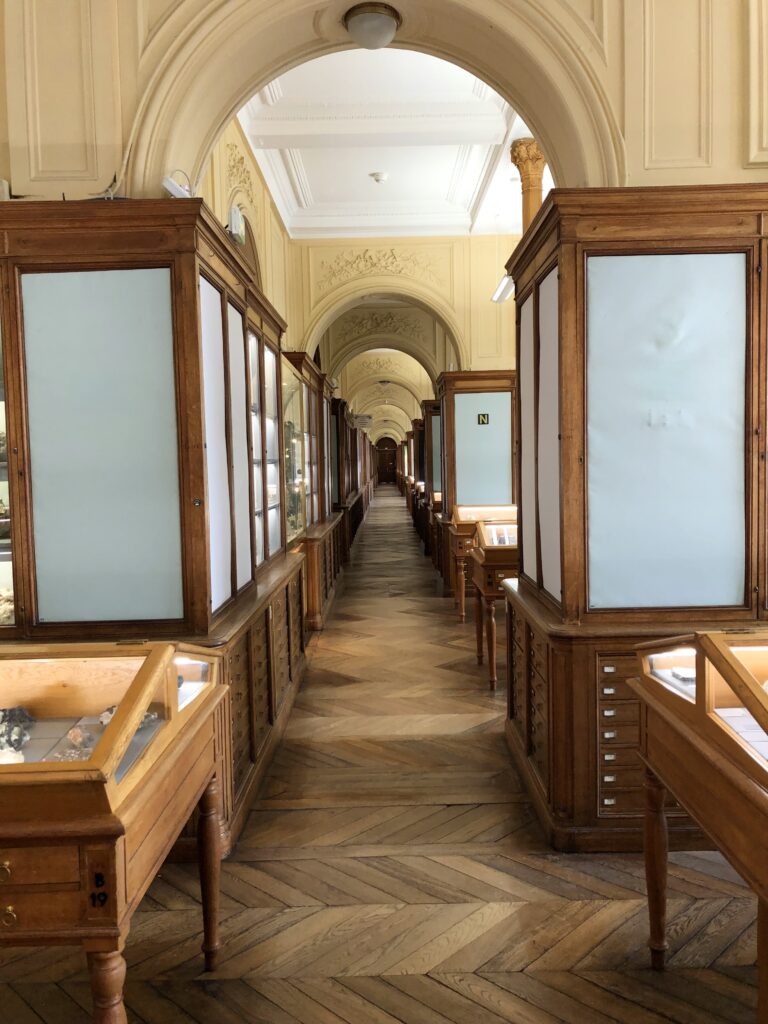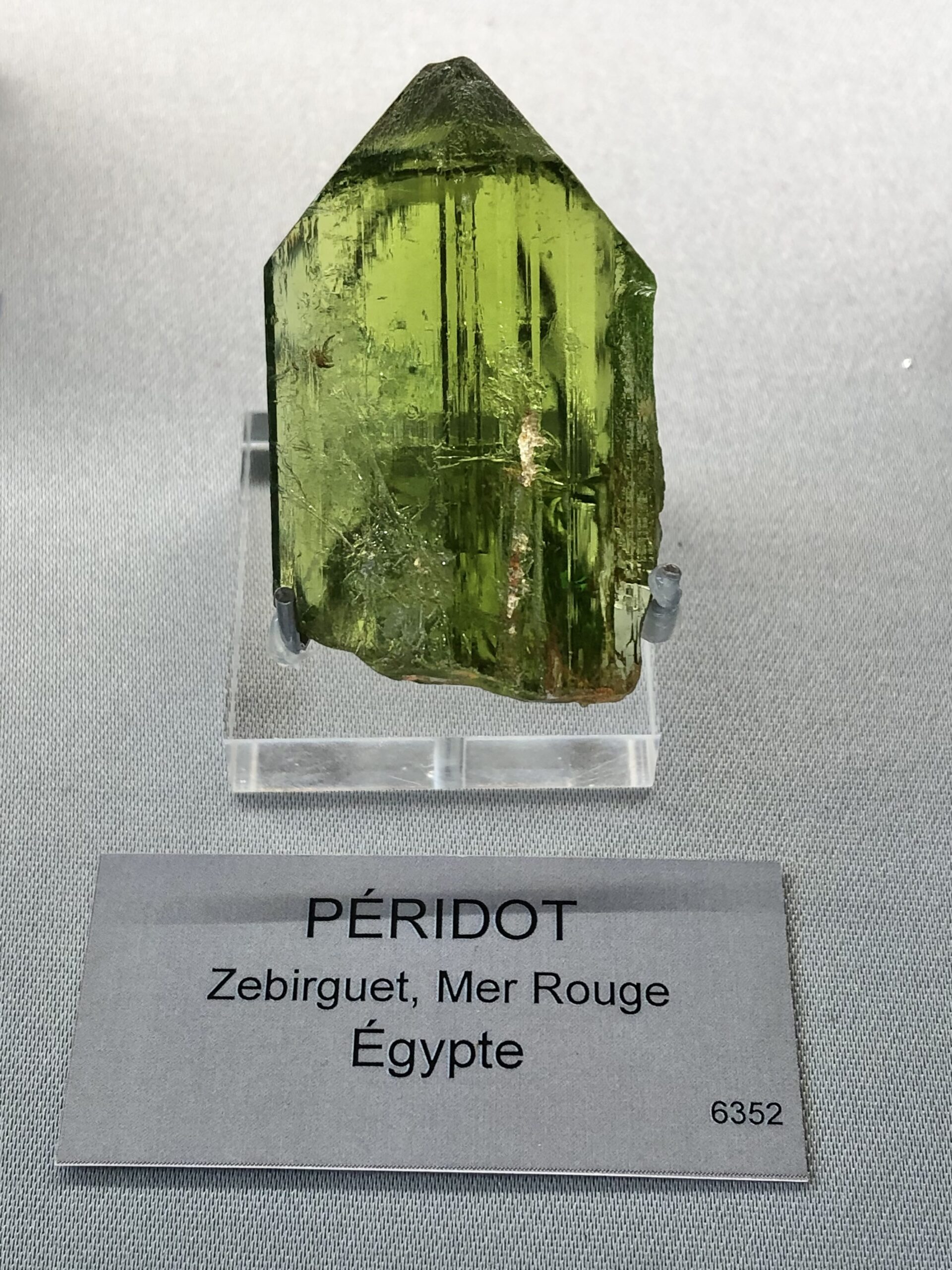Categories
Archives
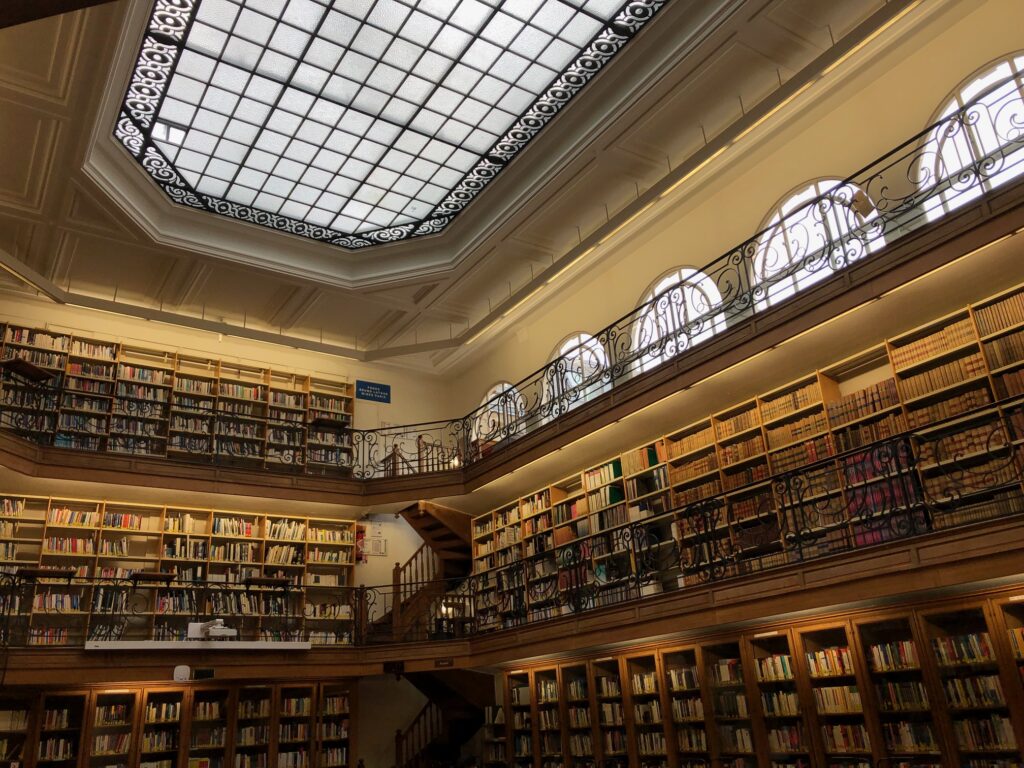 Library at the Paris School of Mines
Library at the Paris School of Mines
In late April, I visited the Mineralogy Museum at L’École des Mines de Paris (the Paris School of Mines). Both the School of Mines and the Museum collection have long histories – they have been part of the world of mineralogy since its early days. The School of Mines was founded in 1783 and has been housed in the beautiful Vendome Hotel (which itself dates to 1707) since 1816.
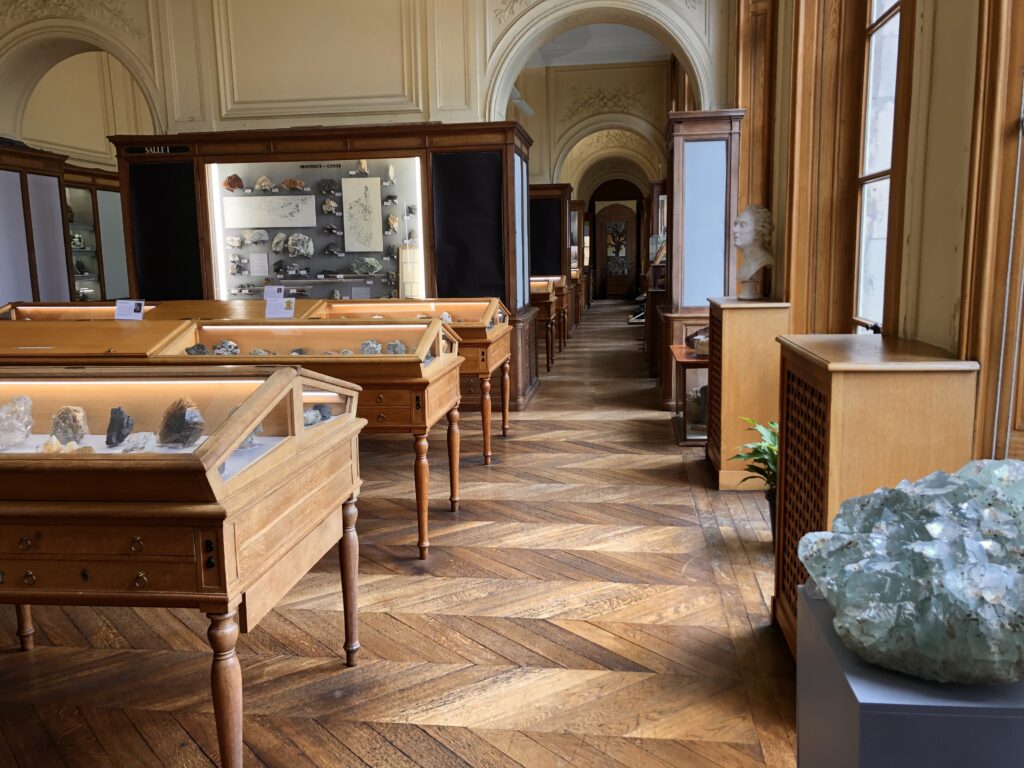 Mineralogy Museum at the Paris School of Mines
Mineralogy Museum at the Paris School of Mines
The Museum galleries display approximately 4,000 of the overall approximately 100,000 specimens in the collection. When you are visiting this collection, you are visiting a collection that has been evolving since the dawn of specimen mineralogy. Few mineral collections have such history. Indeed, the first curator, named in 1794, was Rene Just Haüy (often considered the father of modern crystallography). And some of the first specimens in the collection were seized from collectors among the nobility during the Revolution.
One is struck by the familiar names that appear over the long life of the collection, including curators, mineralogists, donors and collectors whose pieces acquired – these names include Brochant de Villiers, Heuland, Bertrand, Seligmann, Egleston, Mallard, Nordenskiold, Gruner, all of whom have minerals named after them (mineralogists at the Paris School of Mines also included Berthier, Dufrénoy and Senarmont…)
Great Specimens
The collection has a long and storied history, far beyond the scope of what I was hoping to do here: simply give glimpses of a handful of great specimens – some of which are famous, and some of which simply caught my own eye. Given the sheer number of specimens in the galleries, I had to limit my choices – even though I don’t include gem beryl or elbaite here, of course the collection has those too!
Sorry the lighting isn’t better, and the scale is simply the label size (about 5 cm) for reference, but these specimens speak for themselves despite these shortcomings.
So here we go, some of my favourites, including the otherworldly prousitites, in the Mineralogy Museum at the École des Mines:
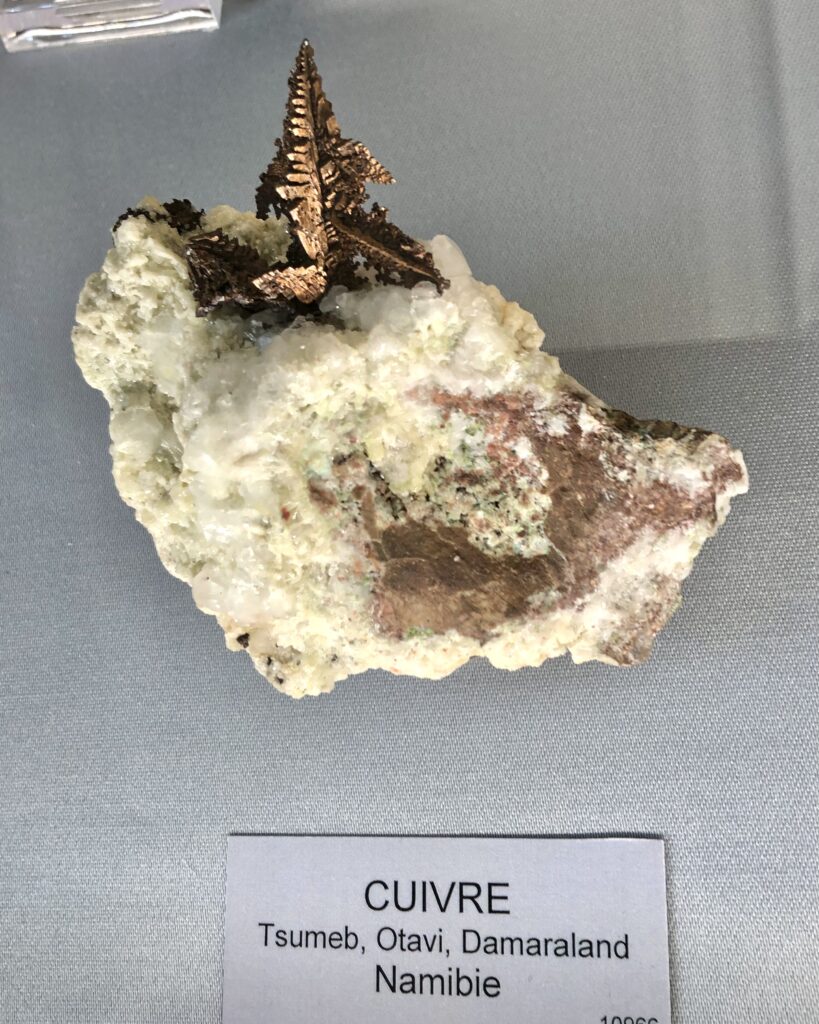 Copper, Tsumeb Mine, Tsumeb, Otavi, Namibia
Copper, Tsumeb Mine, Tsumeb, Otavi, Namibia
 Great case of Italian sulphur specimens
Great case of Italian sulphur specimens
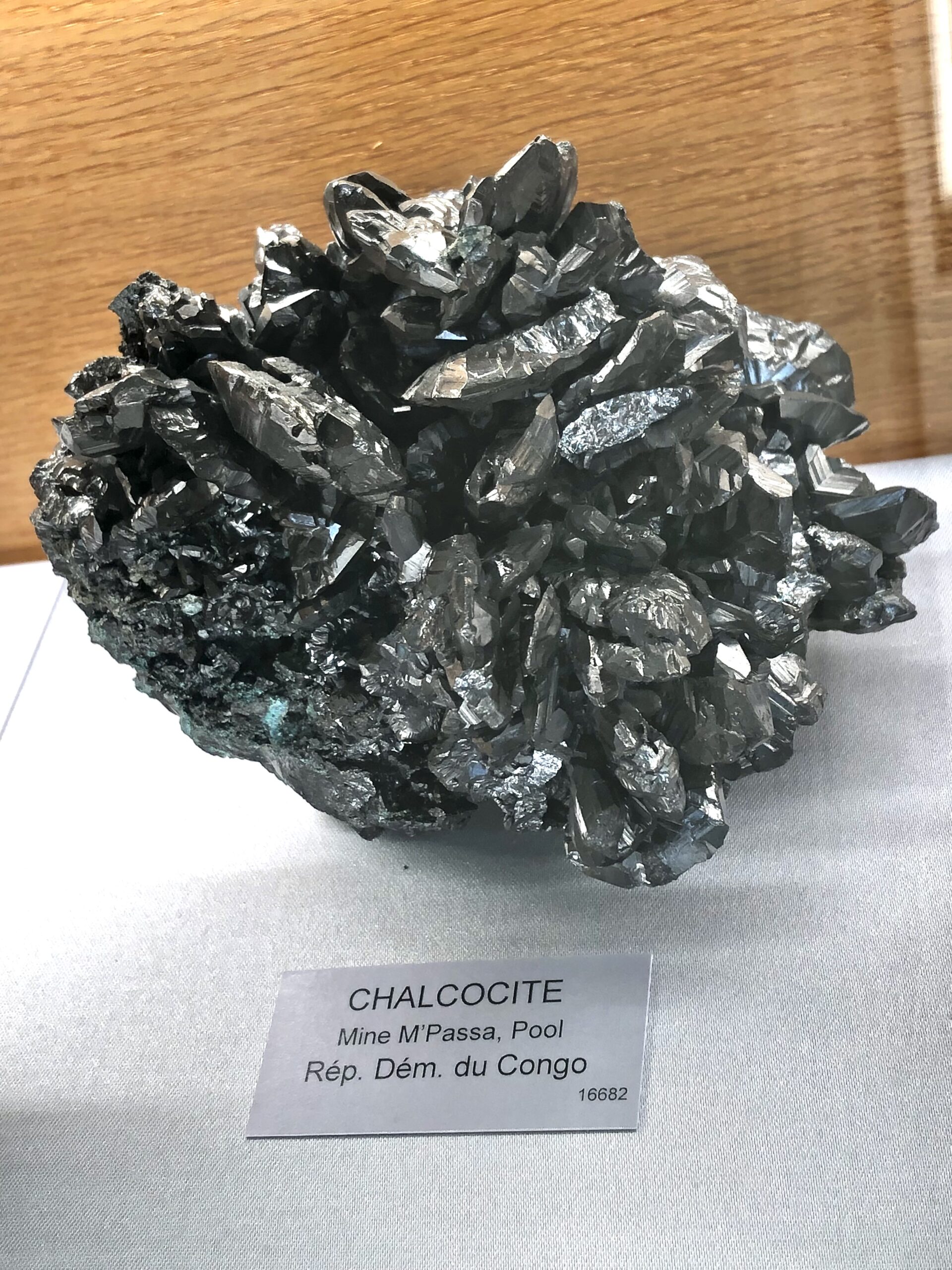 Chalcocite – M’Passa Mine, Mindouli District, Pool Department, Republic of the Congo.
Chalcocite – M’Passa Mine, Mindouli District, Pool Department, Republic of the Congo.
This overall specimen is obviously imperfect, but looking closely, the good crystals are amazing large chalcocites – the one left of centre near the top is an incredible crystal for the species.
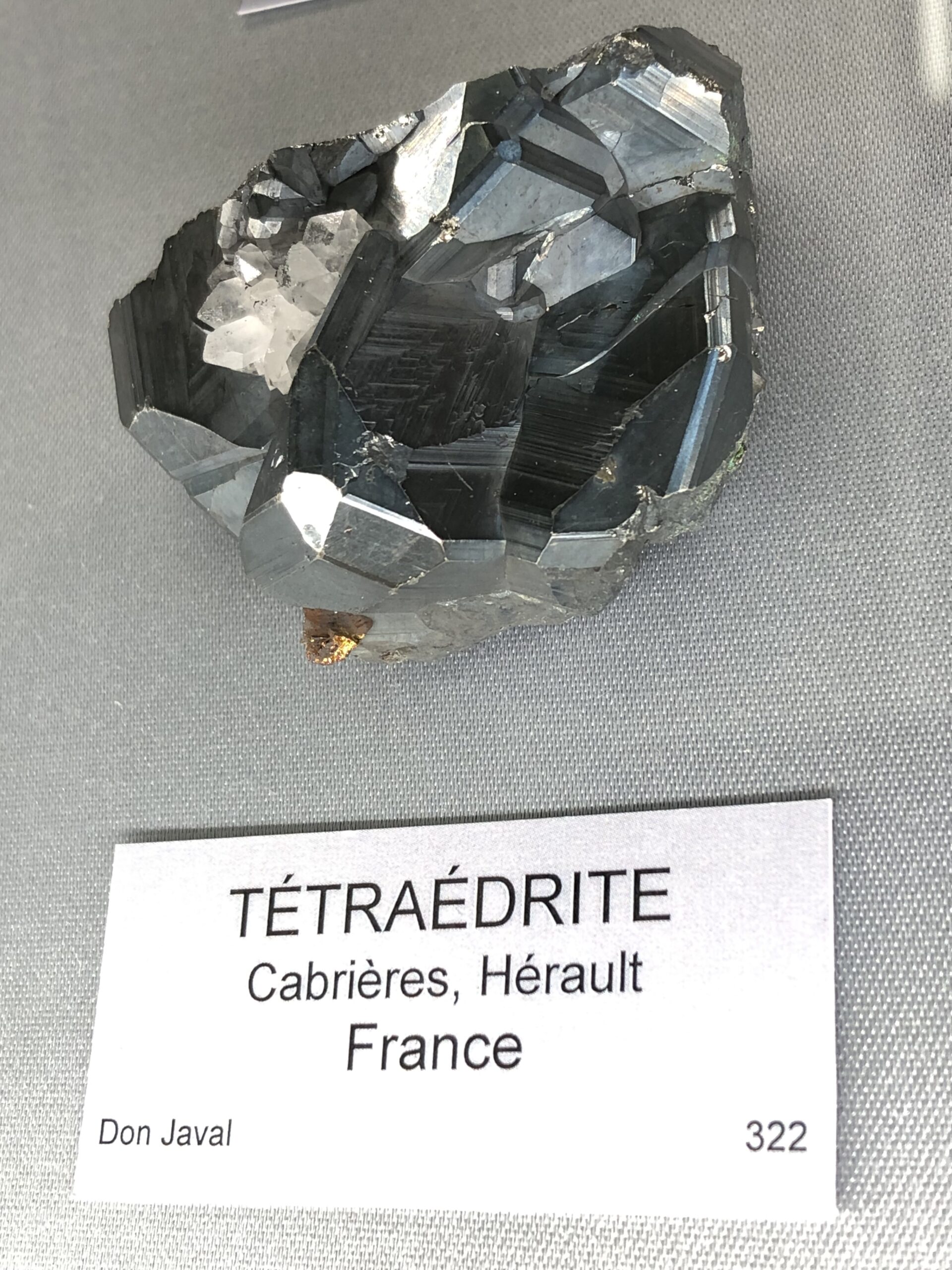 Tetrahedrite – Cabrières, Lodève, Hérault, Occitanie, France
Tetrahedrite – Cabrières, Lodève, Hérault, Occitanie, France
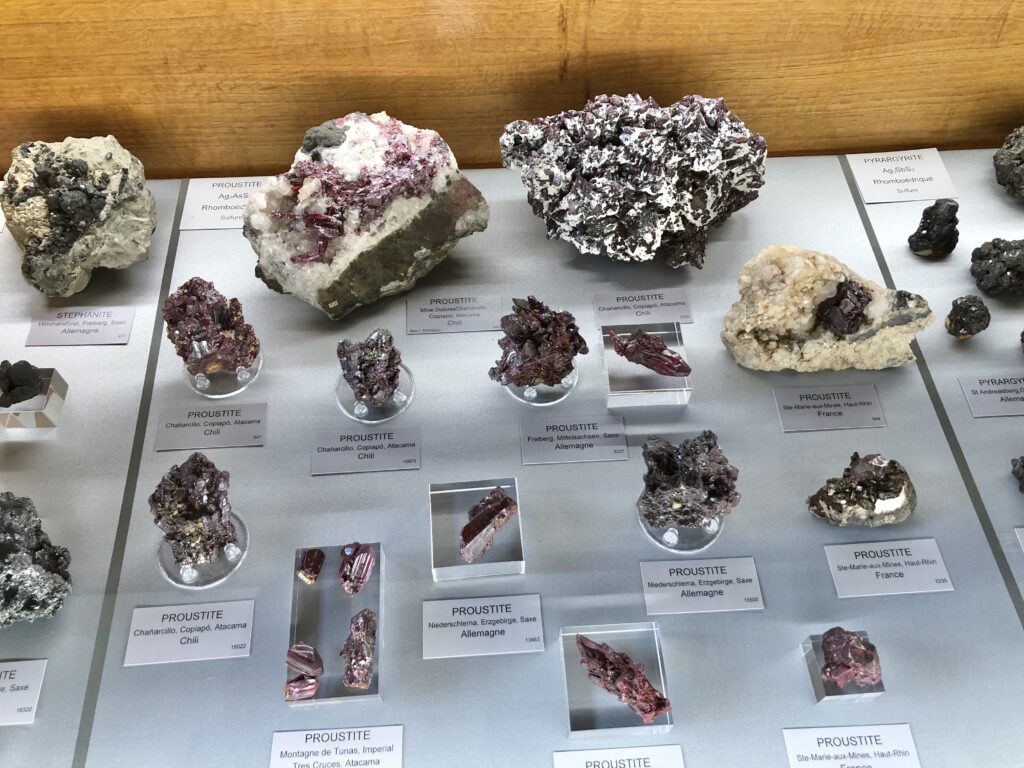 The jaw-dropping proustite case (covered and kept in darkness to protect the pieces)
The jaw-dropping proustite case (covered and kept in darkness to protect the pieces)
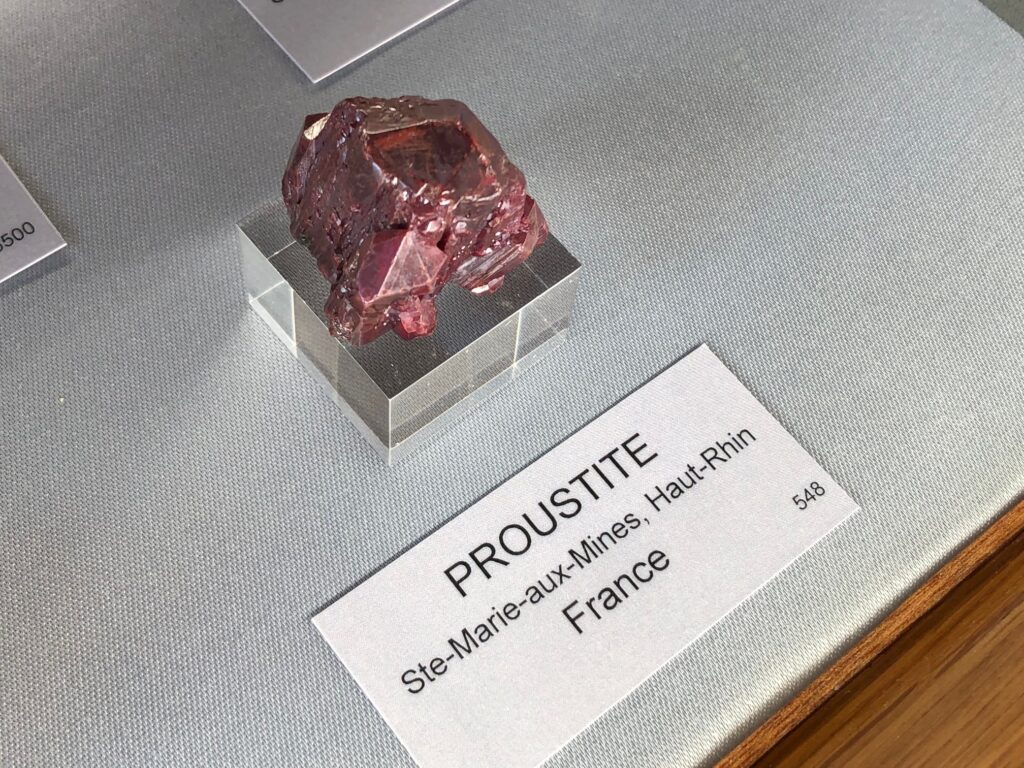 Proustite – amazing for the locality!
Proustite – amazing for the locality!
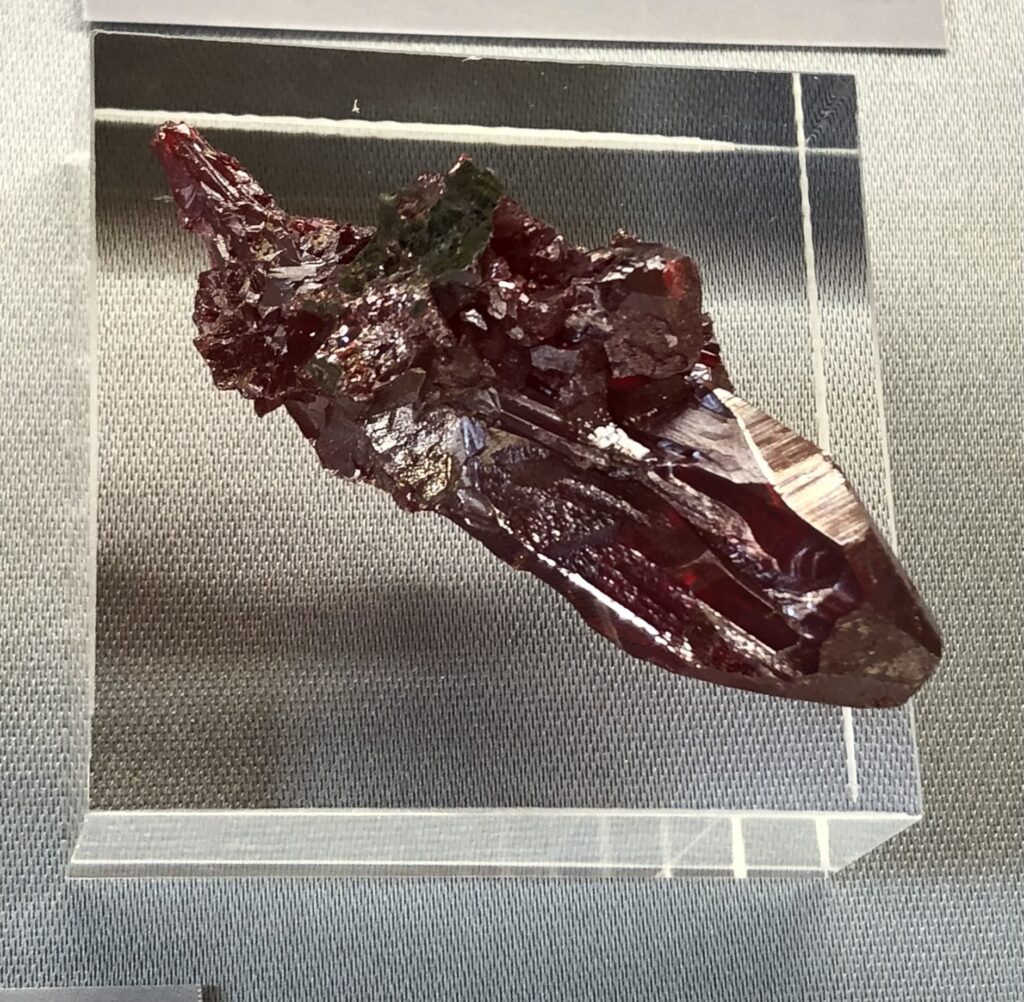 Proustite – Freiberg, Saxony, Germany (about 4 cm)
Proustite – Freiberg, Saxony, Germany (about 4 cm)
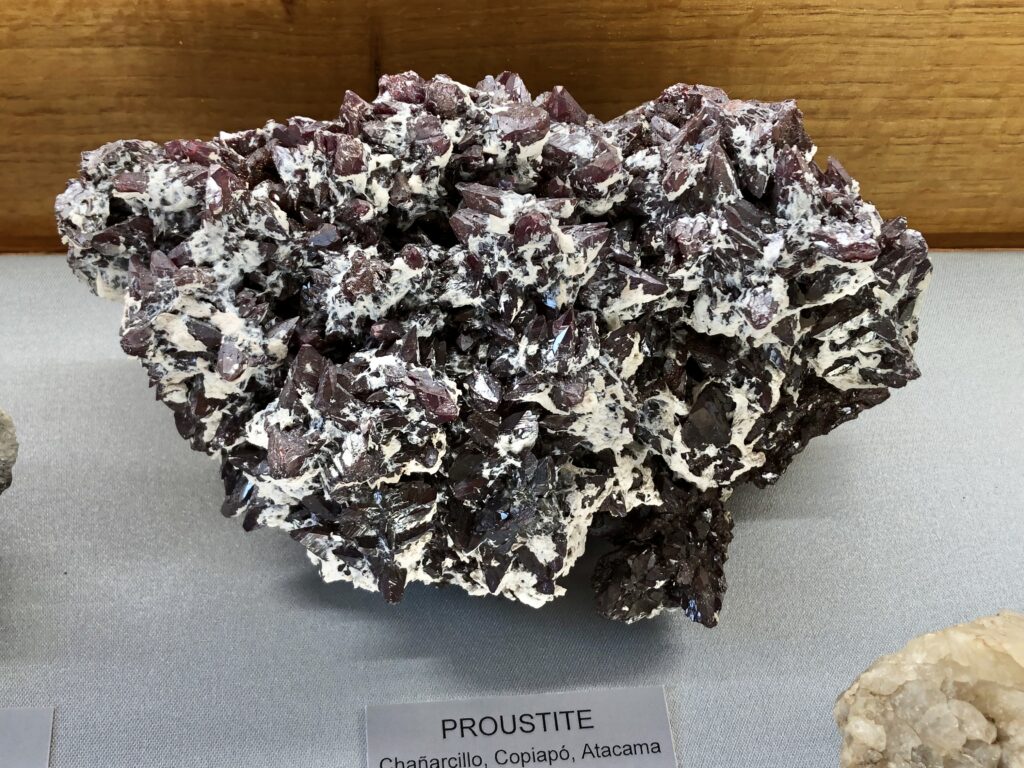 And finally from the proustite case, this huge specimen of proustite crystals from Chañarcillo, the famous 19th century Chilean proustite locality. This specimen is unbelievable in person. You can see from the size of the label that it’s over 15 cm (!).
And finally from the proustite case, this huge specimen of proustite crystals from Chañarcillo, the famous 19th century Chilean proustite locality. This specimen is unbelievable in person. You can see from the size of the label that it’s over 15 cm (!).
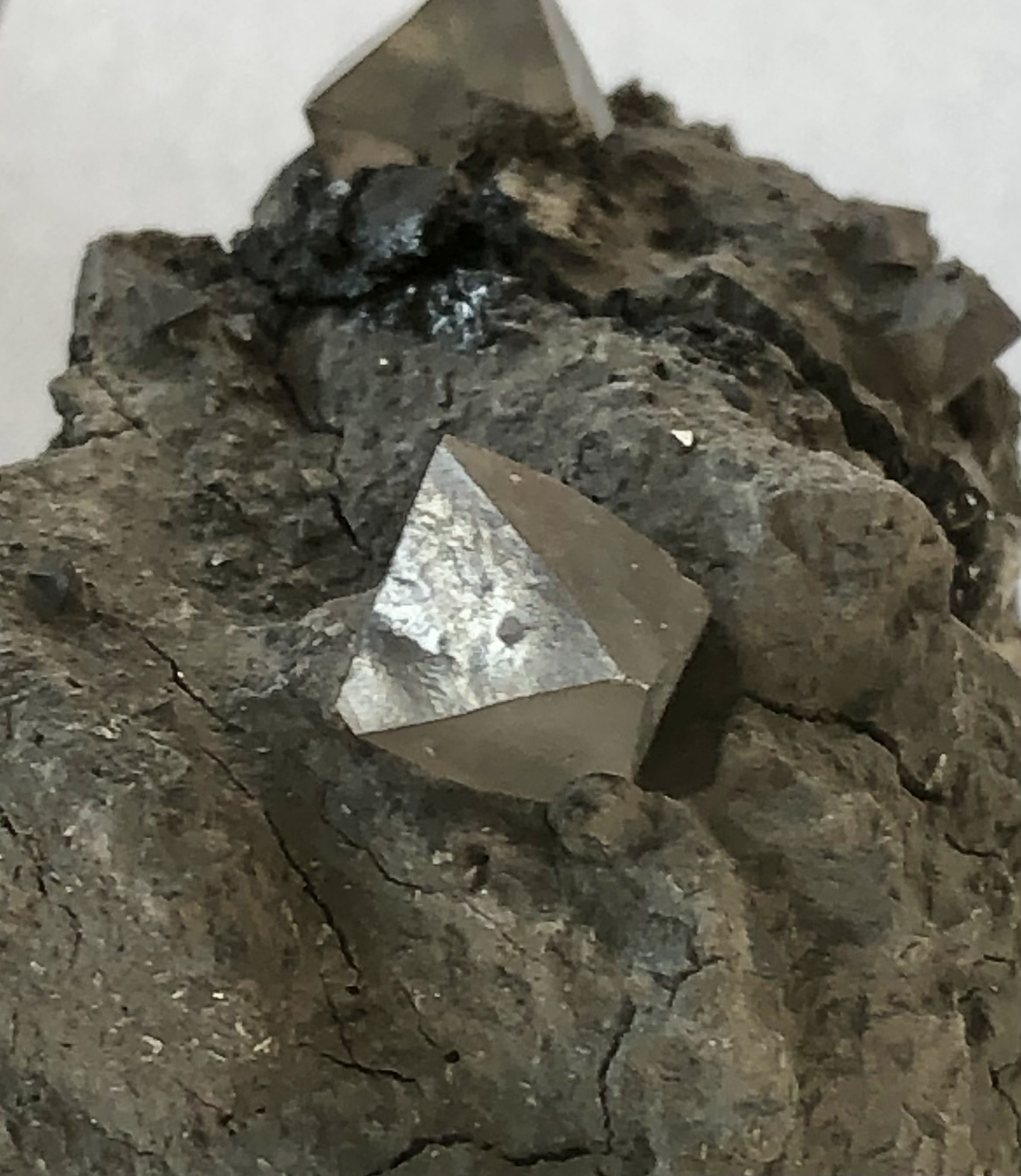 Senarmontite from the type locality, Djebel Hammimat Mine, Aïn Babouche, Ain Babouche District, Oum el Bouaghi Province, Algeria. This crystal is about 1.5 cm – wonderful for this rare species. This locality produced the finest known specimens of senarmontite during the 19th century at the time that Algeria was a colony and then a department of France.
Senarmontite from the type locality, Djebel Hammimat Mine, Aïn Babouche, Ain Babouche District, Oum el Bouaghi Province, Algeria. This crystal is about 1.5 cm – wonderful for this rare species. This locality produced the finest known specimens of senarmontite during the 19th century at the time that Algeria was a colony and then a department of France.
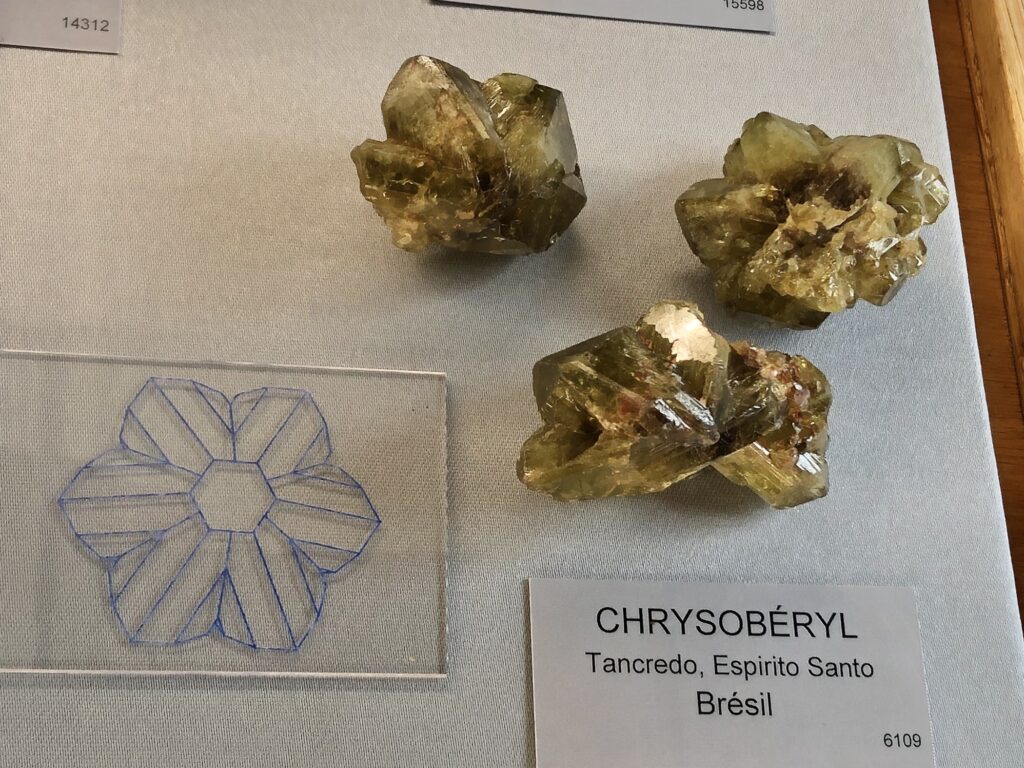 Gorgeous chrysoberyl cyclic twins from the classic occurrence in Espirito Santo.
Gorgeous chrysoberyl cyclic twins from the classic occurrence in Espirito Santo.
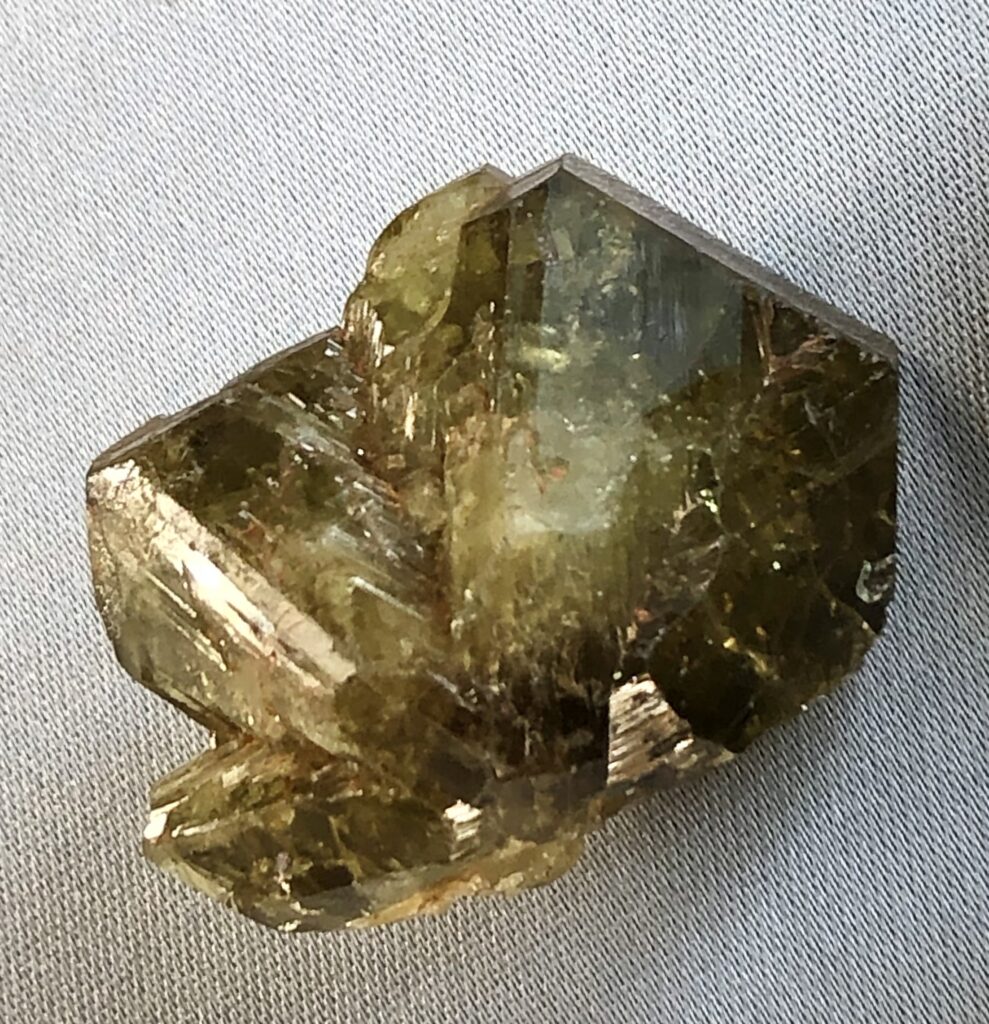 Close-up of one of the cyclic twins, about 4 cm
Close-up of one of the cyclic twins, about 4 cm
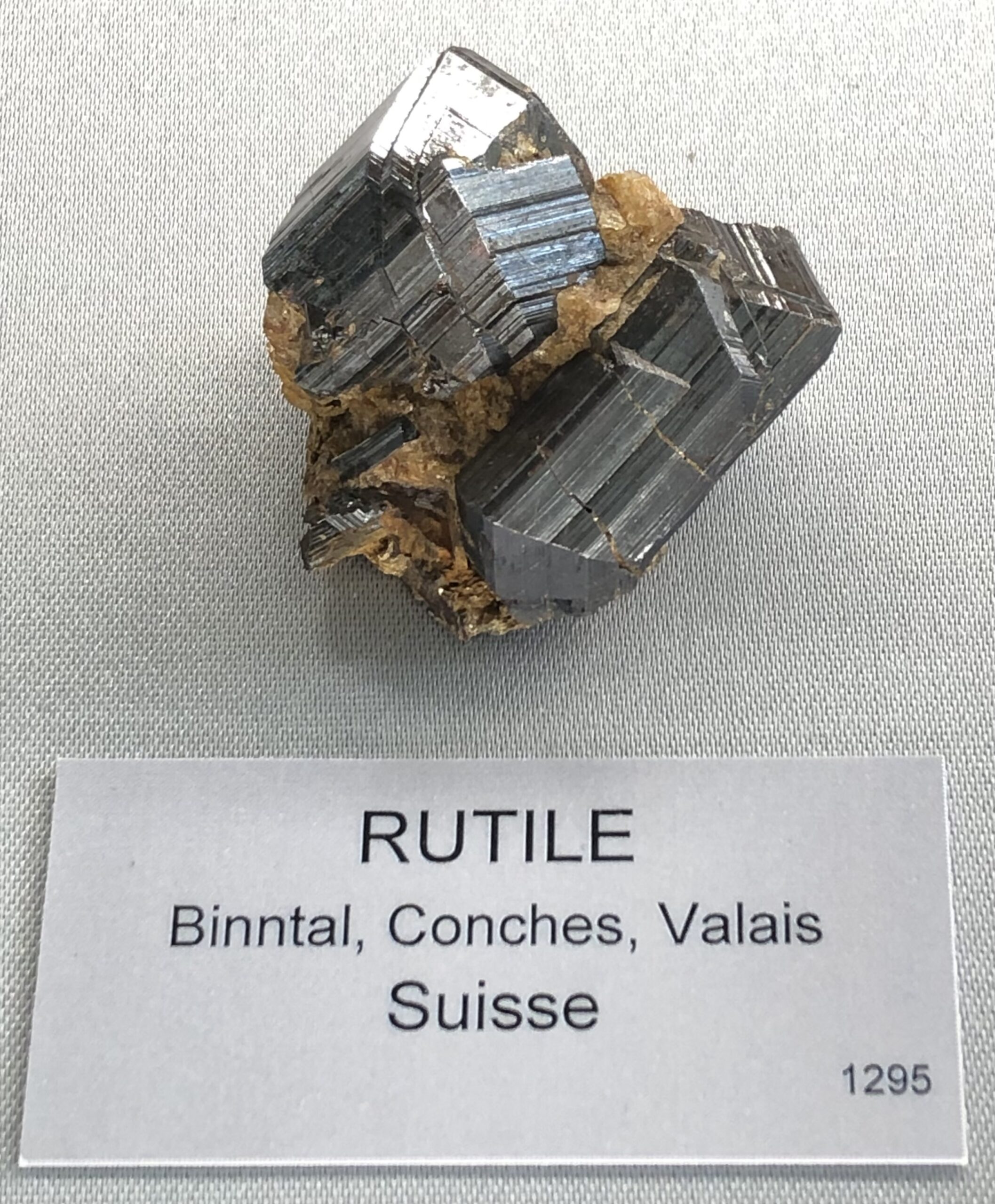 Rutile, twinned, from the Binn Valley, Switzerland. Superb quality snd size for the locality (about 3 cm)
Rutile, twinned, from the Binn Valley, Switzerland. Superb quality snd size for the locality (about 3 cm)
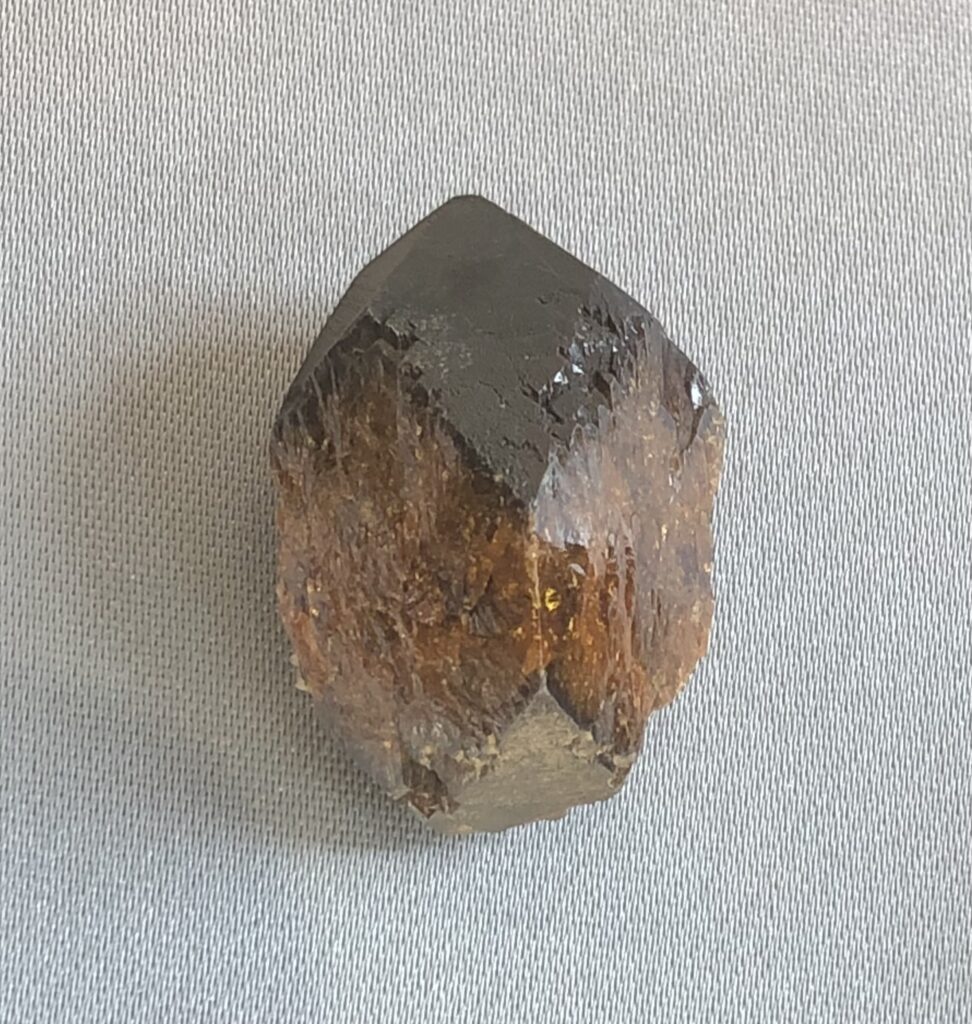 Anatase (blocky), Binn Valley, Switzerland – about 2.5 cm.
Anatase (blocky), Binn Valley, Switzerland – about 2.5 cm.
A wonderful sharp, glassy crystal – amazing for the species.
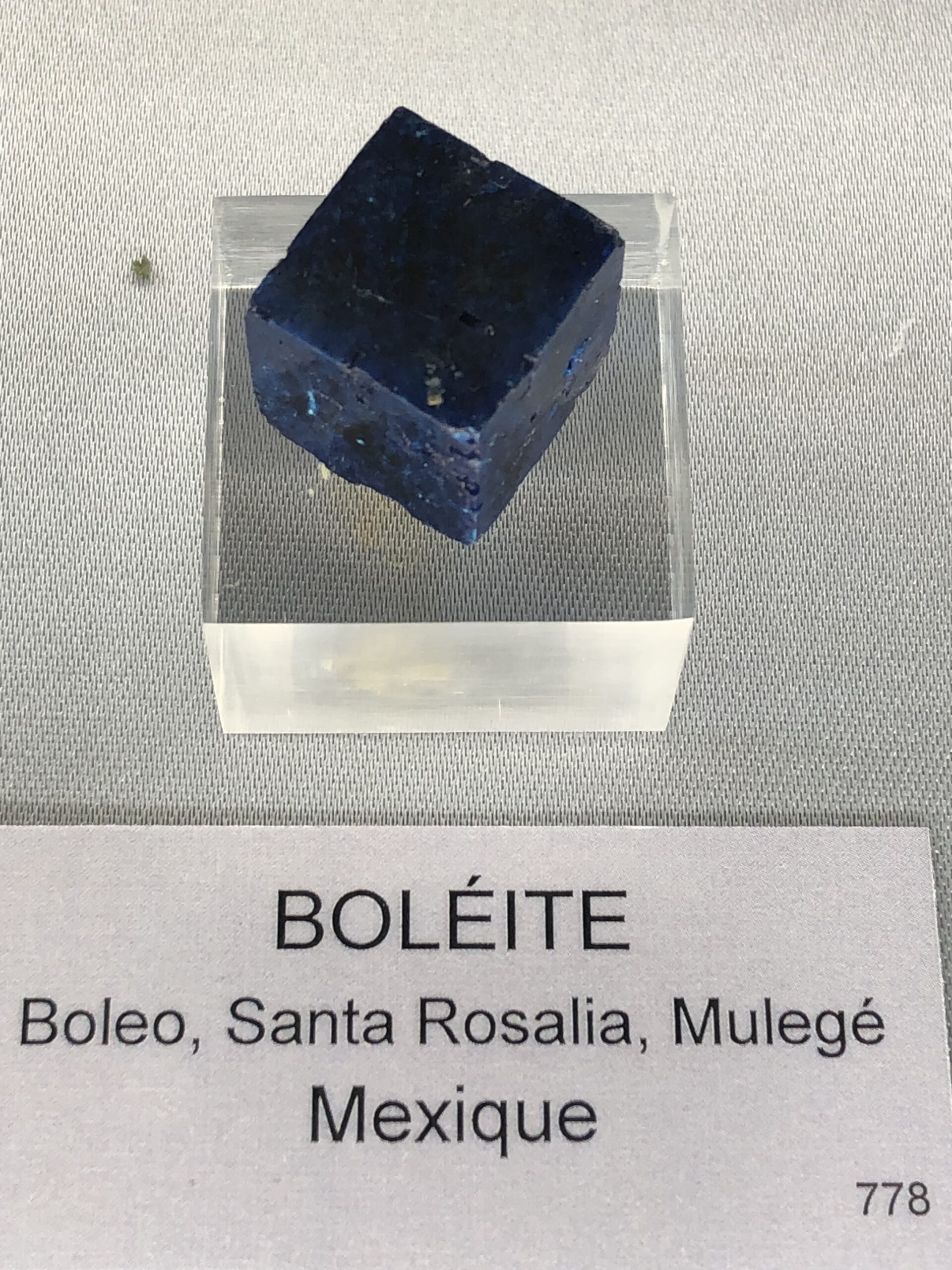 A fantastic boleite, 1.9 cm, from the Edouard Cumenge collection.
A fantastic boleite, 1.9 cm, from the Edouard Cumenge collection.
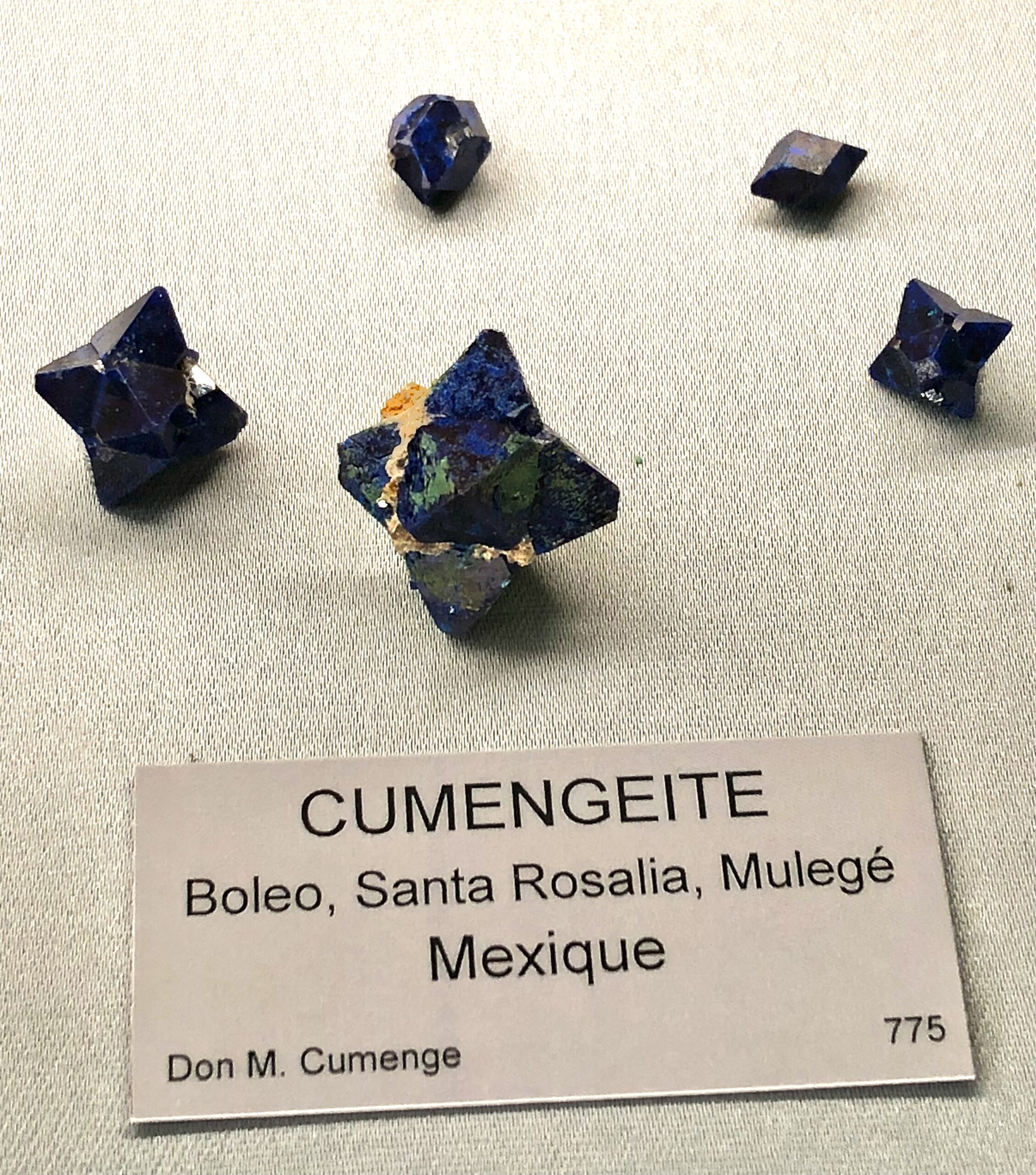 The famous cumengeites, also from the Cumenge collection.
The famous cumengeites, also from the Cumenge collection.
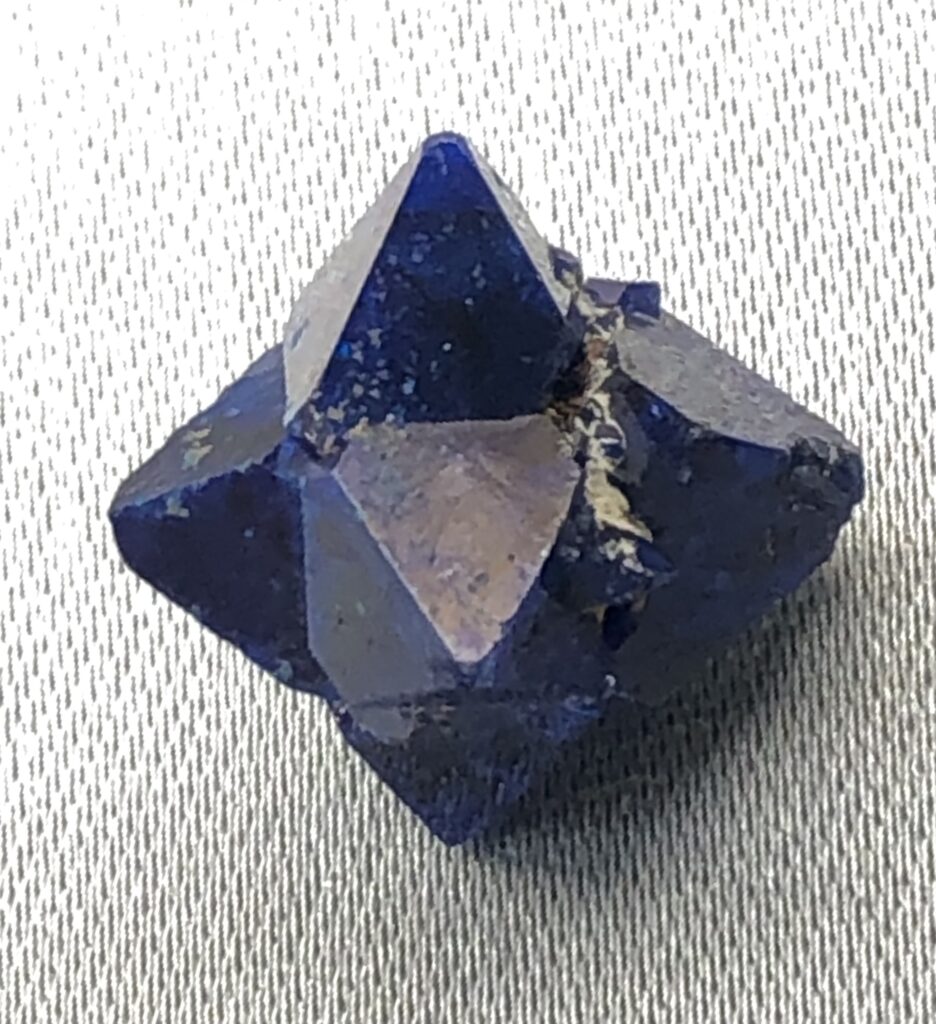 Close-up of one of the cumengeites – intense deep blue, epitactic on a cube of underlying boleite. About 1 cm – and also as good as epitaxy gets – such a great specimen!
Close-up of one of the cumengeites – intense deep blue, epitactic on a cube of underlying boleite. About 1 cm – and also as good as epitaxy gets – such a great specimen!
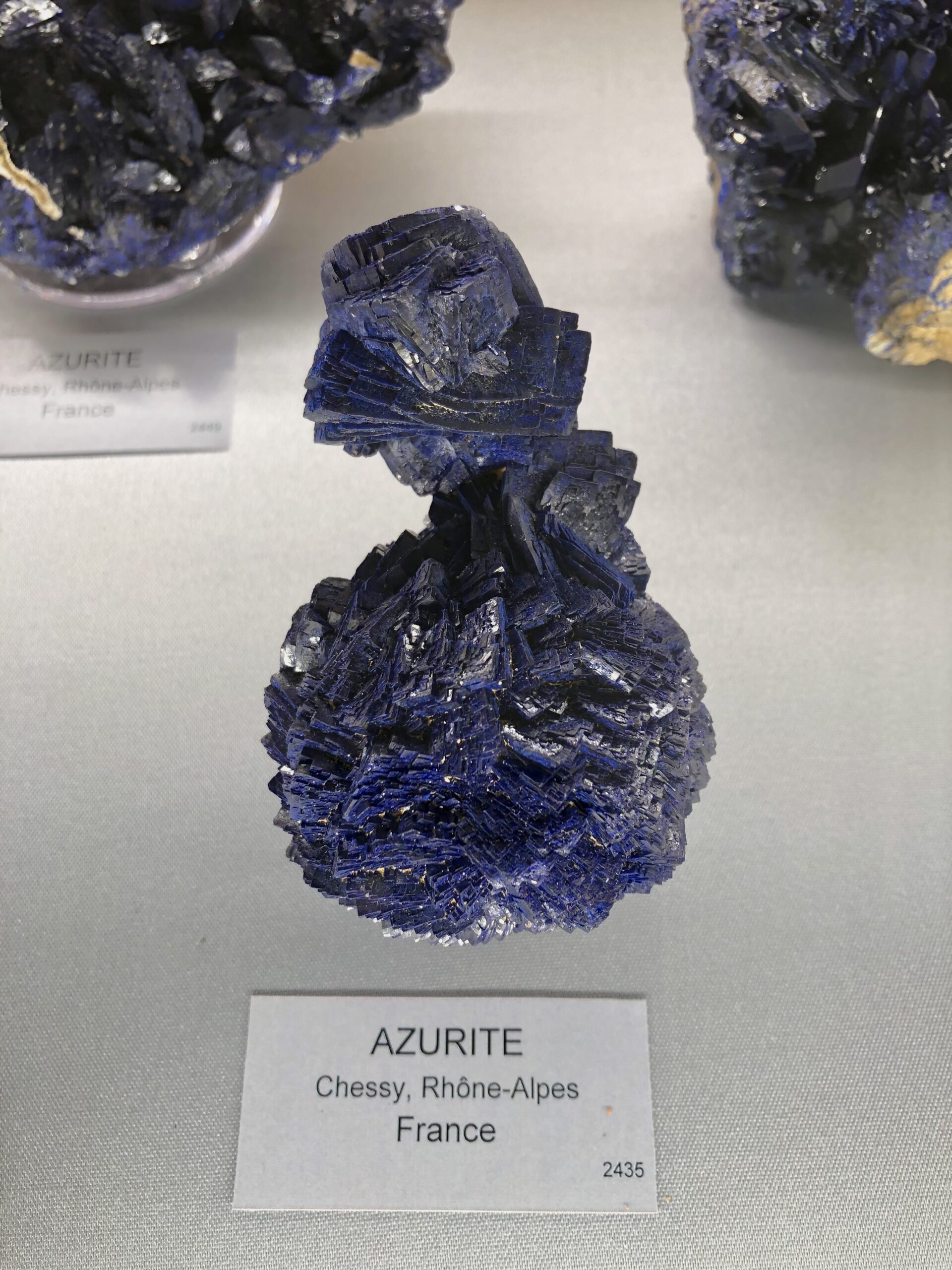 While we’re on the subject of the best deep blues, this is the best Chessy azurite – a famous piece, I’ve seen on display at shows – it is fantastic. About 10 cm.
While we’re on the subject of the best deep blues, this is the best Chessy azurite – a famous piece, I’ve seen on display at shows – it is fantastic. About 10 cm.
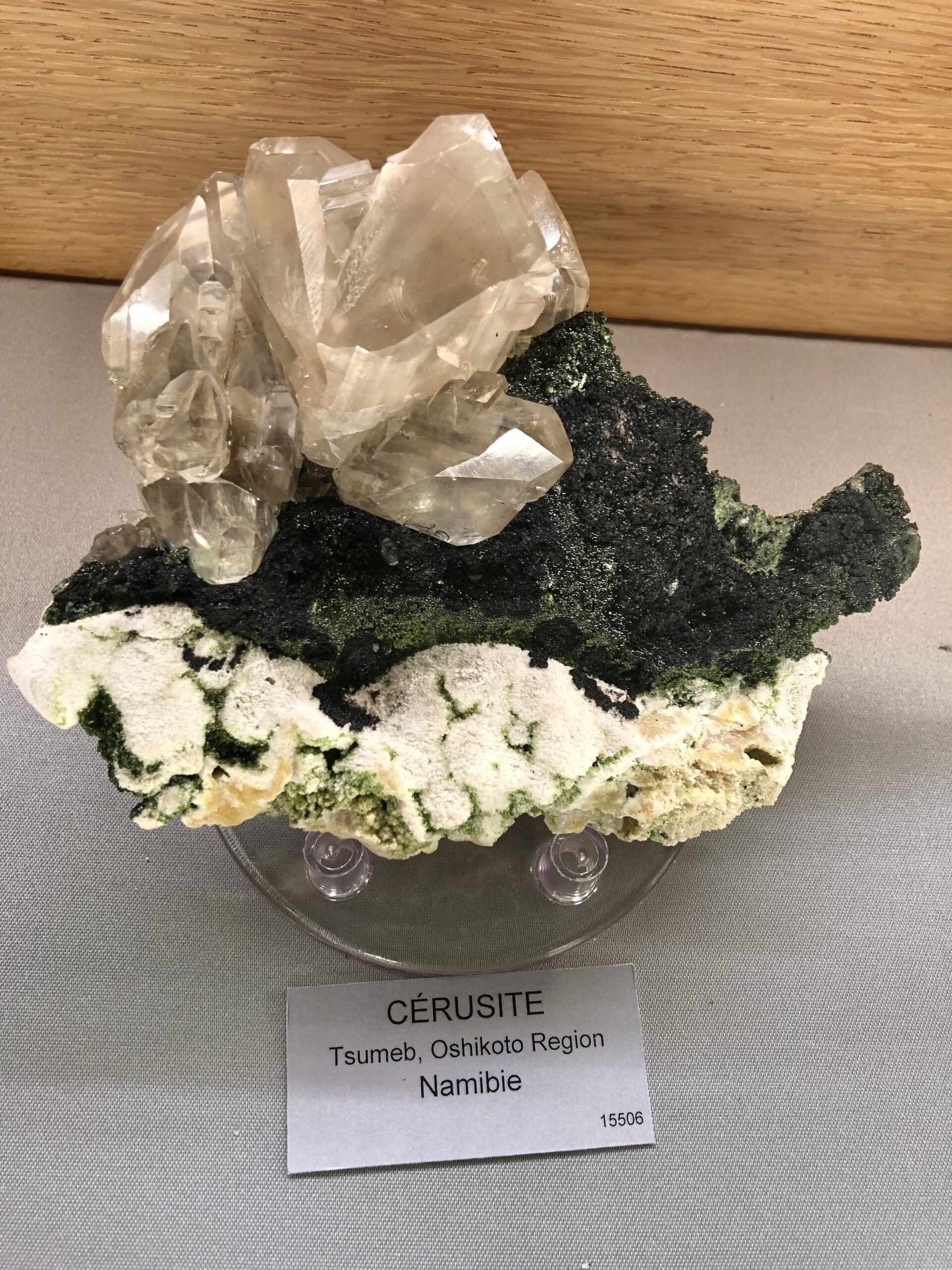 Among the many Tsumeb specimens, this cerussite on mottramite is exquisite and doesn’t fully come through in the photo. The cerussite crystals are glassy, the contrast and aesthetics are great. About 10 cm.
Among the many Tsumeb specimens, this cerussite on mottramite is exquisite and doesn’t fully come through in the photo. The cerussite crystals are glassy, the contrast and aesthetics are great. About 10 cm.
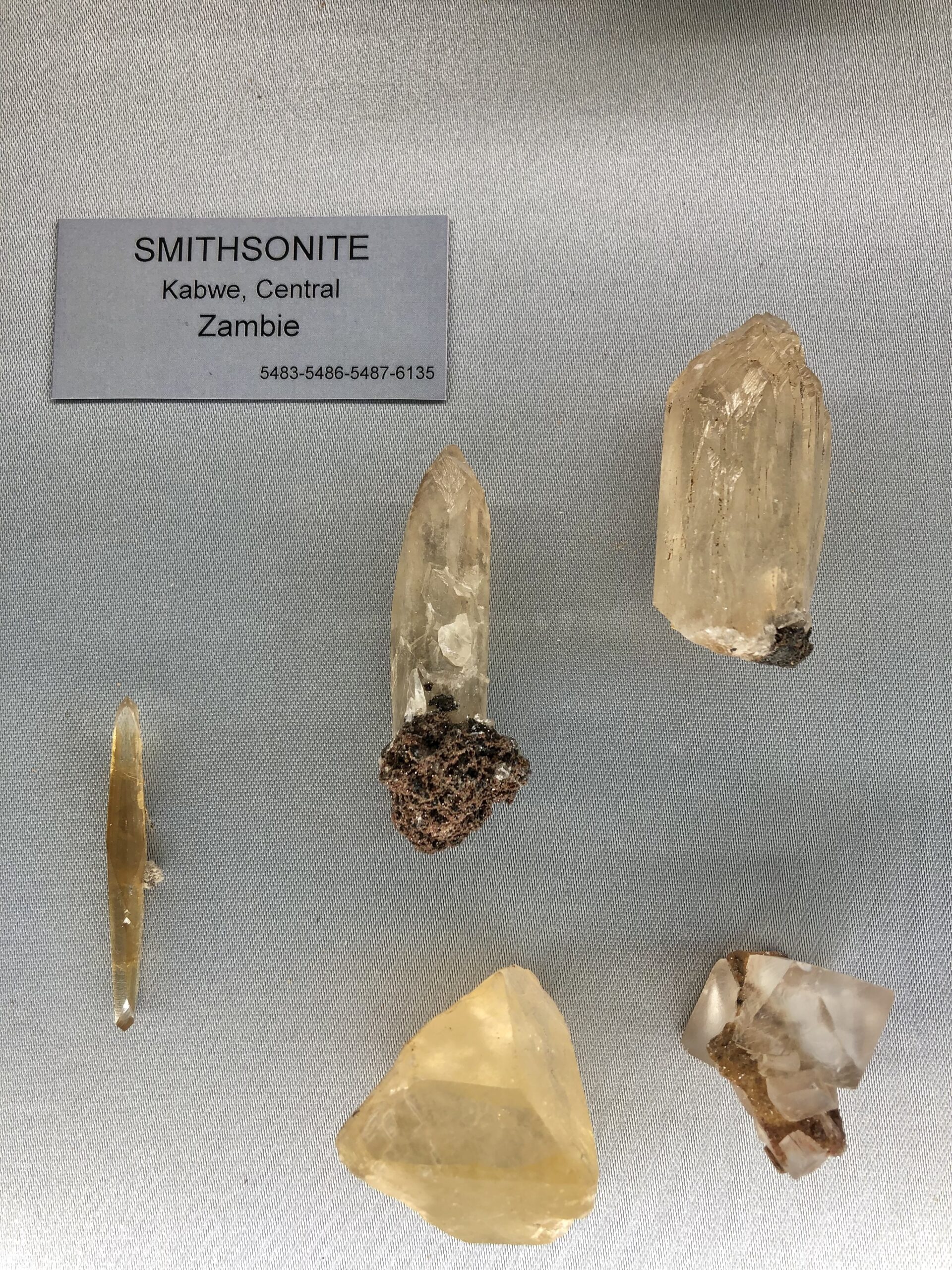 Smithsonite crystals to 5cm from the Kabwe Mine, (“Broken Hill”, until 1966) Kabwe, Kabwe District, Central Province, Zambia
Smithsonite crystals to 5cm from the Kabwe Mine, (“Broken Hill”, until 1966) Kabwe, Kabwe District, Central Province, Zambia
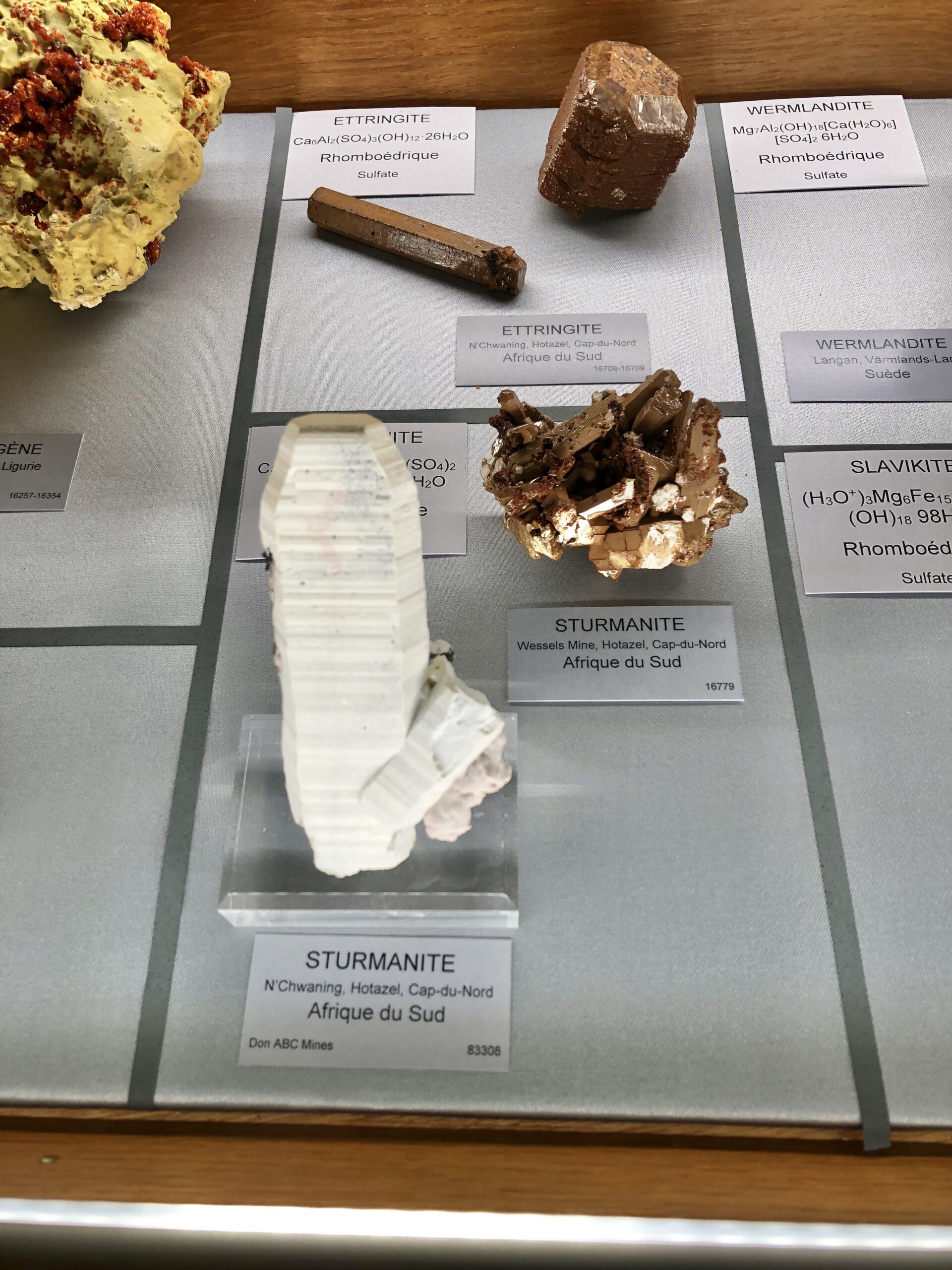 Sturmanite and ettringite specimens (superb quality and size!) from the N’Chwaning Mines, Hotazel, Northern Cape Province, South Africa
Sturmanite and ettringite specimens (superb quality and size!) from the N’Chwaning Mines, Hotazel, Northern Cape Province, South Africa
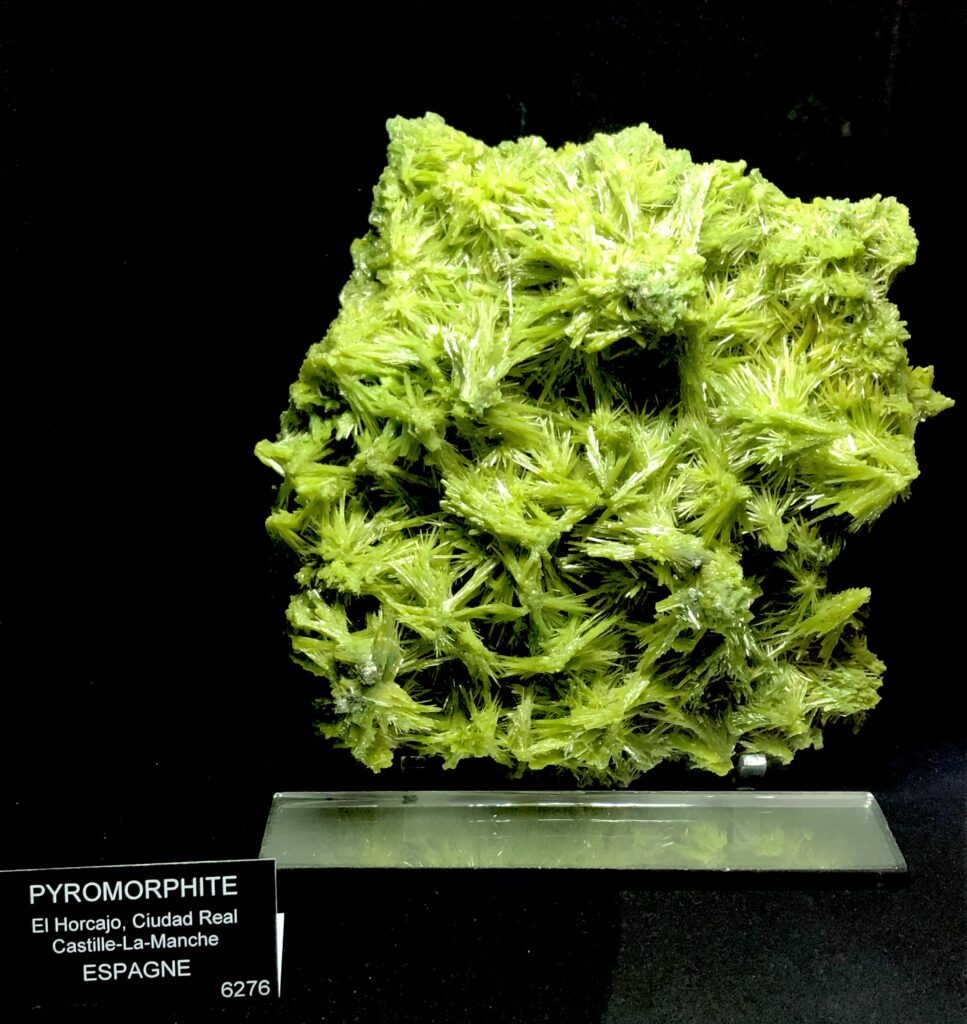 A mind-blowing pyromorphite from the classic El Horcajo mines – this would likely date to the early 20th century. It is about 15 cm and is displayed among featured specimens in the front entry gallery inside the Mineralogy Museum.
A mind-blowing pyromorphite from the classic El Horcajo mines – this would likely date to the early 20th century. It is about 15 cm and is displayed among featured specimens in the front entry gallery inside the Mineralogy Museum.
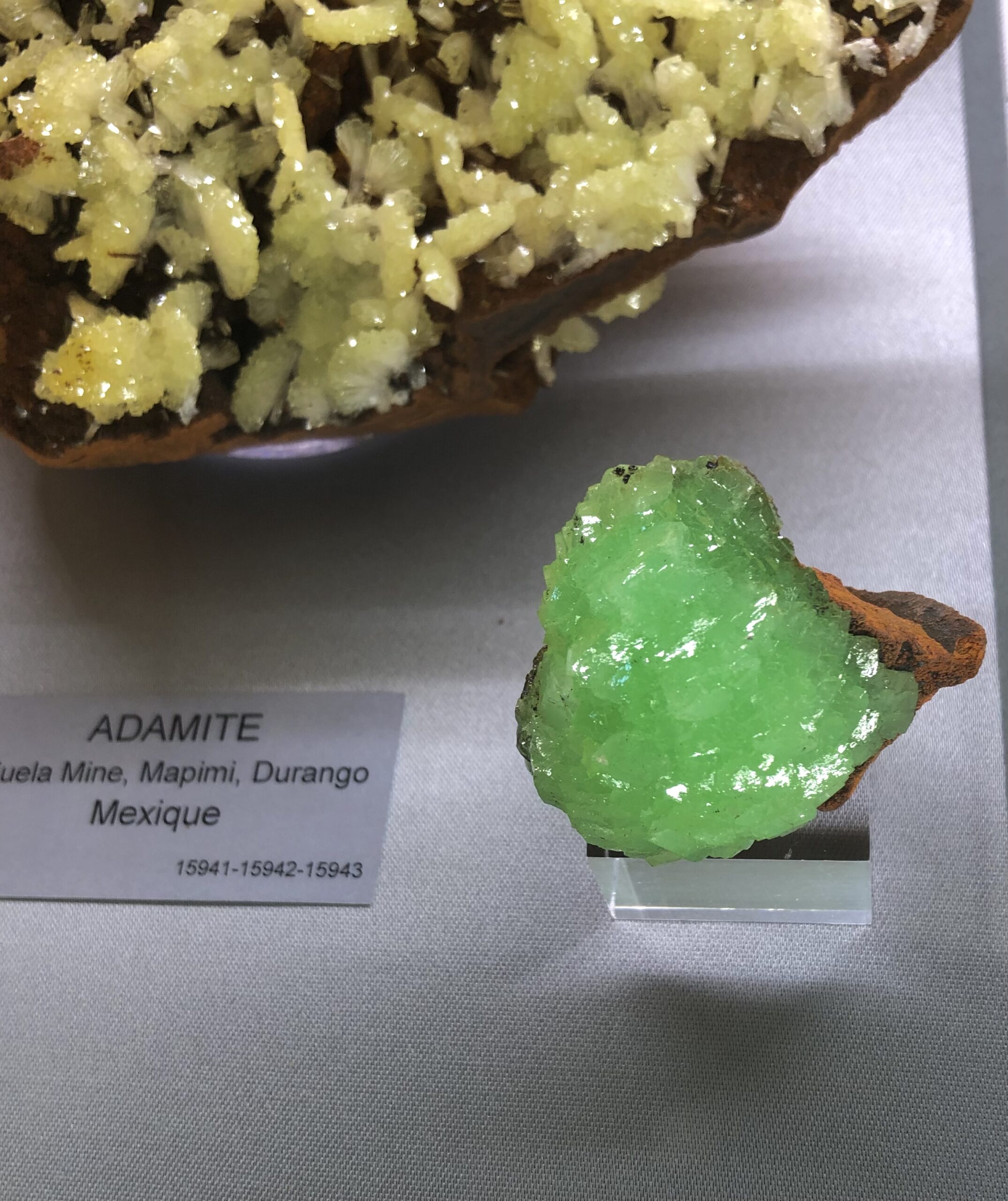 Adamite, Ojuela Mine, Mapimi, Durango, Mexico, about 5cm
Adamite, Ojuela Mine, Mapimi, Durango, Mexico, about 5cm
I have loved this specimen for a long time (having seen it displayed at shows) it just glows!
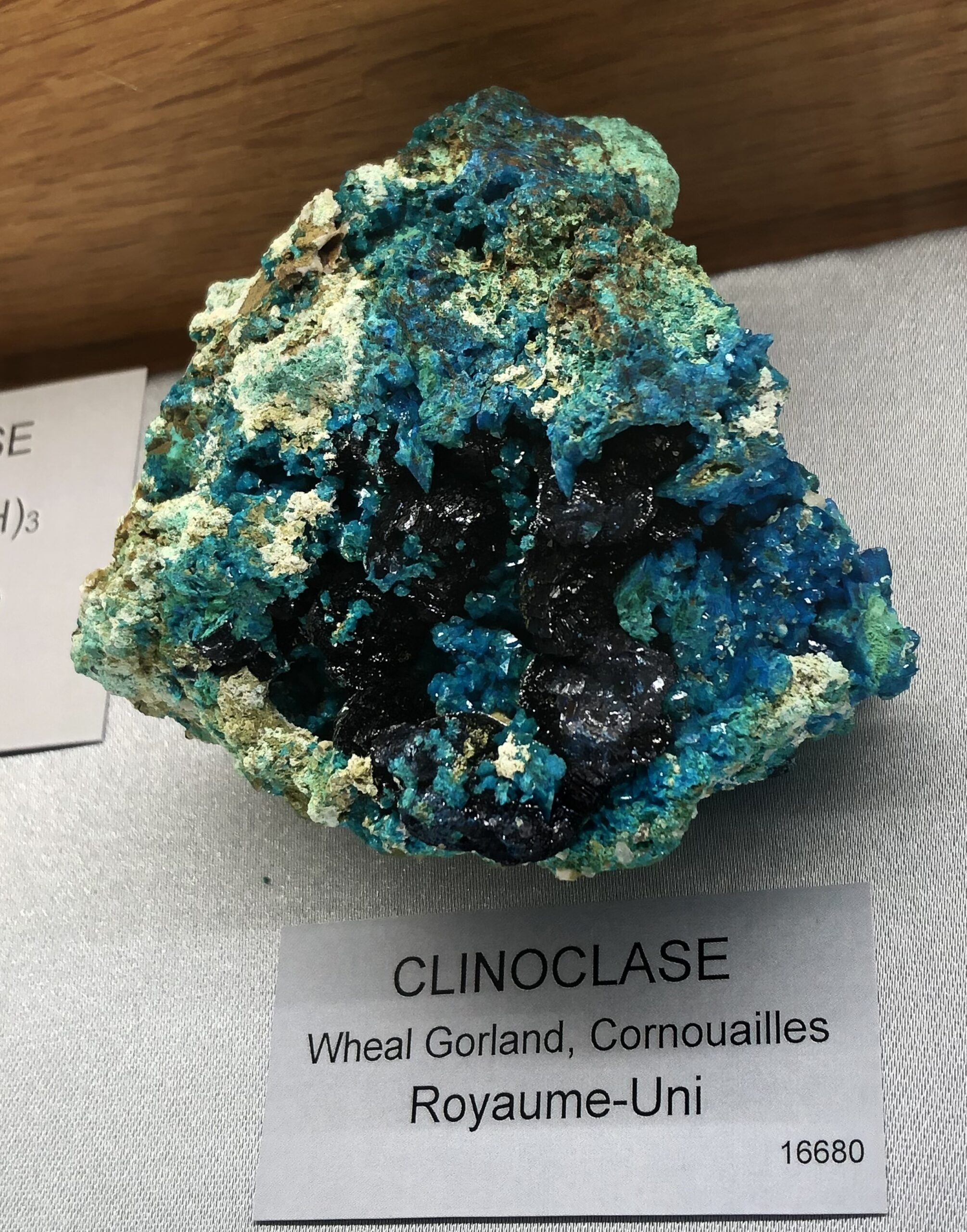 Clinoclase and liroconite from Wheal Gorland, St. Day, Cornwall, UK
Clinoclase and liroconite from Wheal Gorland, St. Day, Cornwall, UK
 A famous specimen – an Ed Over piece, one of the finest Red Cloud wulfenites known.
A famous specimen – an Ed Over piece, one of the finest Red Cloud wulfenites known.
 Cronstedtite – Herja Mine, Baia Mare, Marmures Co., Romania (the mine is near the town of Chuizbaia, and the former Hungarian name for this town is Kisbanya). Cronstedtites from Herja/Kisbanya are the world’s best of species, and this is a wonderful specimen. Although it appears black from distance, on close inspection it has blue hues as well.
Cronstedtite – Herja Mine, Baia Mare, Marmures Co., Romania (the mine is near the town of Chuizbaia, and the former Hungarian name for this town is Kisbanya). Cronstedtites from Herja/Kisbanya are the world’s best of species, and this is a wonderful specimen. Although it appears black from distance, on close inspection it has blue hues as well.
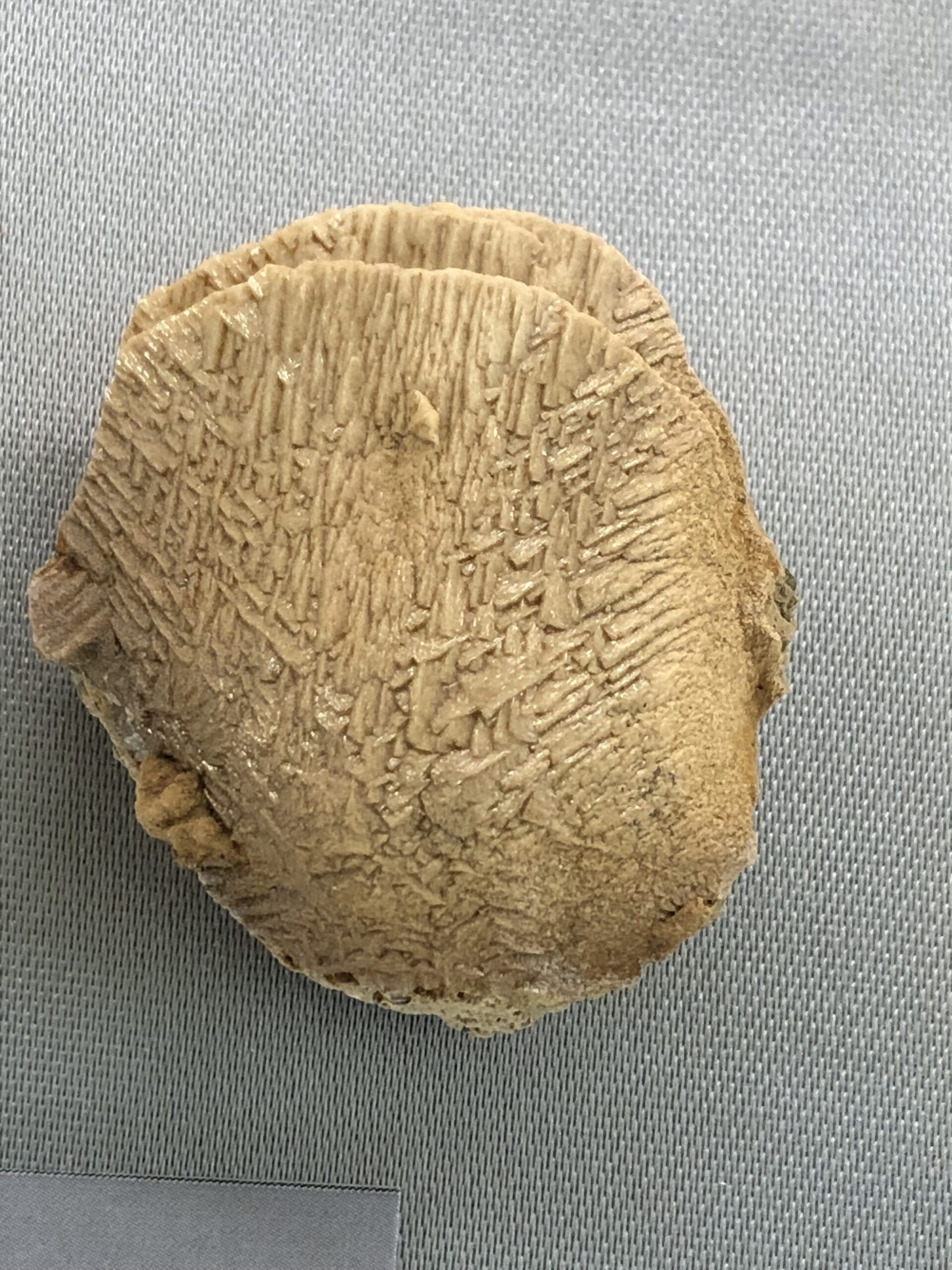 An intricate twin of chabazite, var phacolite, from Dunabogdány, Szentendre District, Pest Co., Hungary – about 2.5 cm. Such exquisite twinning patterns…
An intricate twin of chabazite, var phacolite, from Dunabogdány, Szentendre District, Pest Co., Hungary – about 2.5 cm. Such exquisite twinning patterns…
And finally, I’ll end with one more classic – an astounding gem crystal of forsterite (also known by its broad group name, olivine; this crystal is the gem variety peridot) from Zabargad Island (also known as St. John’s Island and also Topazos), Red Sea Governorate, Egypt. Peridot was mined on St. John’s Island in ancient times – this must be one of the finest crystals to have survived in its natural form – it is huge for the locality.
Of course the above only barely scratch the surface – this is a fabulous collection! Among other things, some specimens just didn’t want to be photographed. For example, on a very high shelf is an unbelievable specimen of two franklinite crystals on a willemite crystal – all well-formed – and if memory serves, the willemite crystal alone is sharp and 10-15 cm, with franklinites maybe 7-8 cm. I could go on about many of the large specimens too – it is a collection that must be absorbed in person to truly breathe it in. Particularly in light of what this collection is – a living, evolving record of mineralogical finds since the earliest days of specimen mineralogy – it’s an amazing collection to experience.


